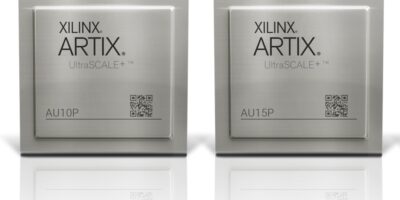UltraScale explores IoT and networking markets
Xilinx has expanded its UltraScale portfolio, with new Artix (pictures) and Zynq UltraScale+ devices for applications which require compact form factors and intelligent edge processing.
The new Artix and Zynq UltraScale+ devices are in compact form factors that are 70 per cent smaller than traditional chip-scale packaging. The 16nm technology devices are in TSMC’s Integrated Fan-Out (InFO) packaging technology and are intended for use in industrial, vision, healthcare, broadcast, consumer, automotive and networking markets.
“Demand for compact, intelligent edge applications is driving the requirement for processing and bandwidth engines to not only provide higher performance, but also new levels of compute density to enable the smallest form factor systems,” said Sumit Shah, senior director, Product Line Management and Marketing at Xilinx. “The new cost-optimised additions . . . . leverage the architecture and production-proven technology of Xilinx’s UltraScale+ FPGAs and MPSoCs.”
The Artix UltraScale+ uses proven FPGA architecture and is suitable for a range of applications including machine vision with advanced sensor technology, high-speed networking, and compact 8K-ready video broadcasting. They deliver 16Gbits per second transceivers to support emerging and advanced protocols in networking, vision, and video. They also deliver the highest DSP compute in its class, said Xilinx.
The new ZU1 and the production-proven ZU2 and ZU3 devices are all in InFO packaging to expand the Zynq UltraScale+ MPSoC range. The ZU1 is designed for connectivity at the edge and for industrial and healthcare IoT systems, including embedded vision cameras, AV-over-IP 4K and 8K-ready streaming, handheld test equipment, as well as consumer and medical applications. It is built for miniaturised compute-intensive applications and is powered by a heterogeneous Arm processor-based multi-core processor subsystem. It is also able to migrate to common package footprints for greater compute performance.
Both the Artix and Zynq UltraScale+ families include the same security features found across the UltraScale+ portfolio, namely RSA-4096 authentication, AES-CGM decryption, DPA countermeasures. They also include Xilinx’s proprietary Security Monitor IP that adapts to security threats across the product life cycle, and which meets the security needs for both defence and commercial projects.
The first Artix UltraScale+ devices are expected to be available in production by Q3 2021, with Vivado Design Suite and Vitis Unified Software Platform tool support starting late summer. Zynq UltraScale+ ZU1 devices will also begin sampling in Q3 with tool support in Q2, with volume production beginning Q4.
The cost-optimised Artix devices and the extension to the Zynq UltraScale+ family join the company’s high-end Virtex UltraScale+ and the midrange Kintex UltraScale+ offerings to provide scalability across a single platform.




